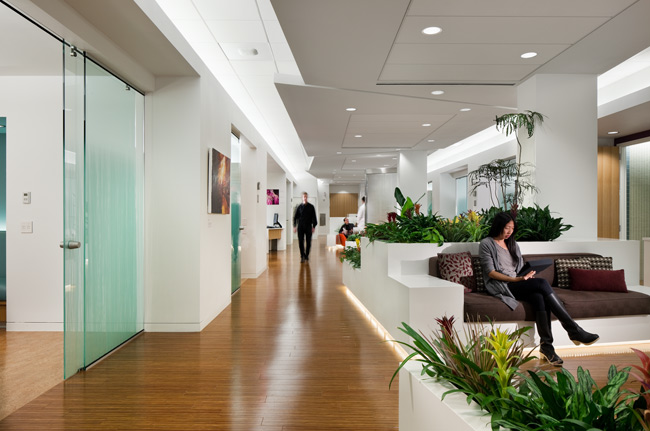Memorial Sloan-Kettering Cancer Center, Brooklyn Infusion Center
Healing Close to Home: A treatment center by ZGF Architects brings patient-focused cancer care to New York's most populous borough.












Architects & Firms
Brooklyn, New York
Along Brooklyn's Atlantic Avenue, buses and cyclists whiz by to the sounds of car horns, laughing children, and the occasional jazz quartet. Blink and you may miss the storefront Brooklyn Infusion Center, the newest treatment facility of Memorial Sloan-Kettering Cancer Center (MSK). Designed by Portland, Oregon–based Zimmer Gunsul Frasca (ZGF) Architects, the 7,745-square-foot clinic, tucked into a ground-level retail space in a new high-end condominium, is a change of scale for the 128-year-old cancer-research and medical-services institute—MSK's flagship hospital on Manhattan's Upper East Side occupies an entire city block. “This is a very nontraditional environment for us,” says Wendy Perchick, chief of strategic planning and innovation at MSK. “I'm still shocked,” she adds with a laugh.
Perchick's humor belies the year of workshops, simulations, and careful planning that went into creating MSK's Brooklyn outpost: Though the prevalence of neighborhood-based cancer care has increased in the last decade, this was uncharted territory for the health-care institution. So, to bring care closer to the 15 percent of its patients living in the borough, MSK worked with ZGF, its oncologists and nurses, and the Boston office of design consultancy IDEO. The team aimed to greatly decrease or even eliminate wait times in the treatment process. Typically, patients wait up to an hour and a half to have their blood drawn and analyzed, and to speak with a physician, before a nurse administers chemotherapy. At the infusion center, nurses make assessments over the phone and pharmacists prepare drugs overnight, so that patients need only arrive and check in on their treatment day, saving time and money for both patients and the hospital.
Getting rid of wait times meant that MSK could take a new approach to the center's layout and programming. For example, the reception area, which in a typical clinic would serve as a waiting room, became a storefront gallery that features the work of Brooklyn-based artists and blends in with Atlantic Avenue's eclectic mix of boutiques, restaurants, bookstores, and antiques shops. The gallery creates a connection to the community by engaging with passersby, as well as benefiting patients, Perchick explains: “Patients said they lose track of time over the course of treatment, so we wanted to provide something that would be visually interesting, dynamic, and changing.”
Three large, storefront windows along the street admit daylight into the gallery and the clinical areas beyond. Because ZGF downsized the reception area, the team was free to create 12 sizable treatment “pods”—averaging 115 square feet—and to include amenities that increase patients' sense of calm, like the four central, plant-filled alcoves that run the length of the Infusion Center. “We looked at this like a public space,” says Jan Carl Willemse, a partner at ZGF who cites New York's pocket parks and Brooklyn's stoops as inspiration. Patients pass through the sun- and LED-lit common areas into the treatment pods, via sliding glass doors that are embossed with a subtle frit of swaying grass. This detail enables nurses to see in and gives patients views out while retaining a sense of privacy. “We wanted to give patients a bit of horizon, so that they didn't have a sense of being closed in,” says Perchick. As treatment sessions can last up to 10 hours, pods are equipped with lounge chairs that feature a high-tech touch-screen console, which allows patients to video-chat with family members and friends, watch the latest episode of their favorite television show, or order food from neighborhood restaurants. The light level in the pods can also be manipulated from the consoles. “So often, people are infantilized by the system that takes care of them,” says Perchick. “So you give back control wherever you can.”
Creating a health-care facility in what was intended for ground-level retail meant conquering obstacles both large and small: Pipes leaked from apartments above, and mechanical systems had to be fitted for use with special health-care equipment. “We also had to work around a lot of structural columns,” Willemse explains. “And because this is a residential building, none of the columns were on a grid.” So ZGF enclosed these structural supports in white synthetic surfacing, creating banquettes for each of the four communal alcoves. “And there are everyday challenges,” adds Jeanine Gordon, a lead nurse at the center. “We still have to deal with noisy neighbors.” Despite these annoyances and the busy city street, not much disturbs the center's quiet, restorative atmosphere.
The warm, patient-oriented space also encourages the kind of spontaneous activity uncommon in health-care facilities. “I received a picture one day of a woman receiving chemotherapy in one of these bays,” says Perchick. “And next to her was her teenage daughter, playing the cello for her. She had drawn up the nurse's chair and brought it close to her mom. There's nowhere else I know where a patient's family member would say, 'I can do that here.'”
Size: 7,745 square feet
Completion date:October 2010
Architect:
ZGF Architects LLP
1223 SW Washington Street, Suite 200
Portland, OR 97205
ZGF Architects LLP
419 Park Avenue South, 20th Floor
New York, New York 10016
PeopleOwner: Memorial Sloan-Kettering Cancer Center
Architect:
ZGF Architects LLP
Personnel in architect's firm who should receive special credit: Interior designer: ZGF Architects LLP
Engineer(s):
Other:
General contractor:
Photographer(s): Renderer(s): ZGF Architects LLP, Brian Stevens
CAD system, project management, or other software used: |
Products
Doors
Locksets: Marks
Acoustical ceilings: Armstrong
Reception furniture:
Fixed seating:
Chairs:
Tables:
Upholstery: Maharam, Design-tex
Genernal Interior: Central Garden Water feature: Aqua Design Group, Brooklyn, NY, stainless steel frame and mesh panel Plumbing fixtures: Lav: Duravit Vero, Faucet:Hansgrohe Axor, Watercloset: Kohler Kingston and Sloan Handsinks, Elkay and Toto |







